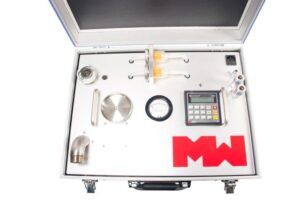PFSA Product Brochure.

To find out more about our Pulverised Fuel Sampler Automatic (PFSA) please feel
free to download product brochure:
The Pulverised Fuel Sampler Automatic

To find out more about our Pulverised Fuel Sampler Automatic (PFSA) please feel
free to download product brochure:

The Pulverized Fuel Sampler Automatic (PFSA) is a portable fuel particulate analyzer used for sampling fuel particulate flows carried within the airstream. The samples are extracted from the full cross section of the fuel pipe in accordance with the international standard ISO 9931 and can be used to determine the fuel mass-flow in the pipe.
For optimal measurements, the PFSA should be used together with a M&W Dirty Air Pitot (DAP) or Dirty Air Pitot Laser (DAPL) to ensure a fully isokinetic sample. By using the DAPL the PFSA can receive data directly via Bluetooth.
The Pulverised Fuel Sampler Automatic (PFSA) includes a portable aluminum control box, a power-driven sampling lance with a rotating head with 4 sampling nozzles, a high efficiency precipitating cyclone, a sample bottle, a reinforced compressed air hose, a power cable for the control box, and a connecting cable for sampling lance.
The sampling process with the PFSA begins by automated preheating of the sampling lance, after which the sampling lance is inserted into the fuel pipe through a dustless connection. Once the sampling lance is in place, the sampling sequence is initiated from the operator panel located on the portable control box. The sampling sequence spans four minutes and is carried out according to the ISO 9931 standard.
When initiated, the sampling is automatically run and monitored by a PLC in the portable control box, each time providing a full and precise sample of fuel particulates independent of the human factor. Besides obvious advantages for the operator this increases representativity and reproducibility of the measurement. During the sampling sequence the sampling head is automatically rotated, so that a sample is taken from 64 sampling areas evenly distributed over the cross-section of a circular pipe. This thorough coverage is essential for accurately capturing the characteristics of the fuel particulates within the pipe. Throughout the sampling sequence the fuel particulates are automatically separated in the cyclone and collected in the sample bottle.
After the sampling sequence is completed, the sampling lance is withdrawn from the fuel pipe and the sample bottle is detached. The mass of the fuel sample is then determined with use of the weighing scale conveniently integrated in the control box. The weighing scale directly communicates with the PLC for immediate and convenient data processing.
In order to ensure isokinetic extraction, we recommend using the PFSA in combination with the separately available M&W Dirty Air Pitot Laser (DAPL) which is used to measure the flow velocity in the fuel pipe prior to the PFSA measurement. The PFSA and the DAPL instruments are able to exchange values directly by wireless communication.
Options
The PFSA can be delivered with a Snap Lock Dustless Connector (PFSA-SL). This product has been developed by M&W in order to help customer to save time and provide an easy way to secure a connection between the fuel pipe and measuring instrument. The design enables insertion of the measuring instrument into the fuel pipe with internal over-pressure which reduces leakage of coal-dust and provides a gas tight sealing.
Nota Bene 1
M&W offers customers a facility for quantitative assessment of the performance following one or several types of analysis such as Variographic Characterisation or a Replication Experiment based on the customer’s own material.
Cookie Settings is not available. Cookie Consent is disabled or is just disabled for your country.